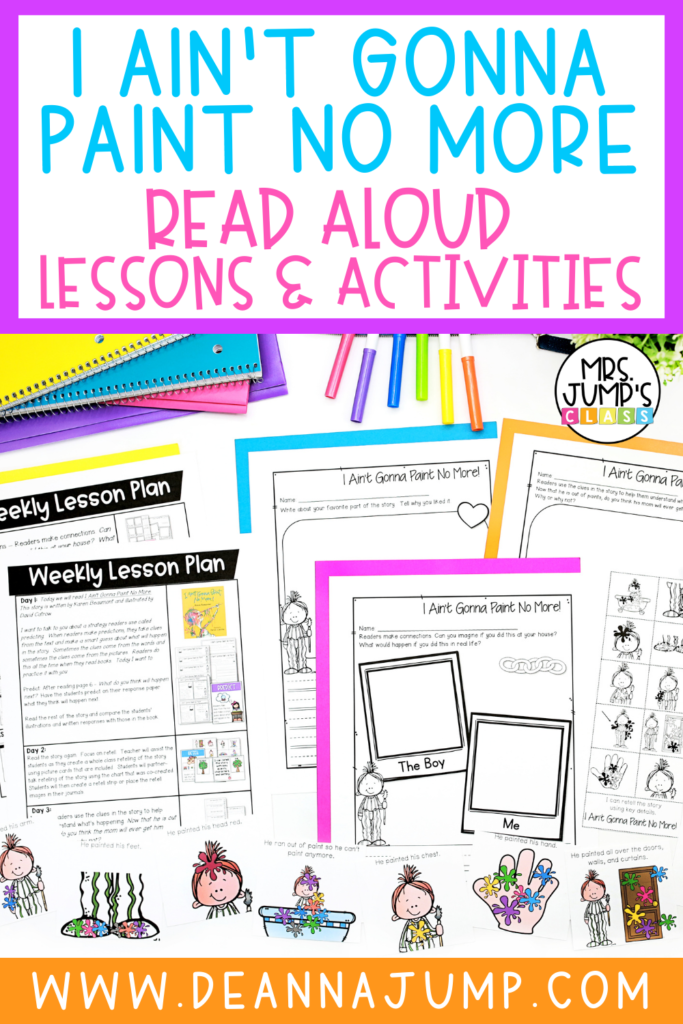Read alouds are a wonderful resource to use in the classroom. They allow students to hear a fantastic story. Additionally, teachers can work on so many literary skills throughout one book. However, a key aspect involves engagement. Students need to be interested in the story to focus on skills, such as characters, vocabulary, and predictions. Thankfully, the I Ain’t Gonna Paint No More read aloud will create excitement in every student! The fun book and the Engaging Reader Lesson Plans will ensure students are focused and engaged!
Importance of Read Alouds
Honestly, there are not enough words to express how powerful teacher read alouds are. When students get to listen, they do not need to decode words or pause at punctuation. Instead, they simply get to focus on the meaning of the story and build their comprehension skills. While students must learn to read independently, read-aloud time is absolutely essential. Best of all, students LOVE to listen to their teacher read. After finishing a book, they almost always beg the teacher to reread the story. Or, select a new book and keep reading. Either way, students just love to listen to their teacher read a story.
Rereading Importance
There are times during the year when teachers need a story for a specific event. This may be reading a story at Open House or as part of a holiday celebration. Students simply get to sit and enjoy the story. However, rereading the story when working on literary strategies is essential. Ultimately, this allows children time to work on many different skills, such as predictions and connections.
Engaging Reader Lesson Plans
This incredible resource includes everything needed for the I Ain’t Gonna Paint No More read aloud! Students will love this story while working on many incredible lessons and activities. There are 5 days of lesson plans to guide instruction in comprehension, responding to literature, sentence studies, crafts, and more! Honestly, this reading program allows students to fall in love with characters, respond in various formats, and discuss with peers.
Before we dive into the lesson components, do not worry about finding the book! You can find an AMAZING video of I Ain’t Gonna Paint No More! It even shows the beautiful illustrations in the book.
Differentiation with I Ain’t Gonna Paint No More Read Aloud
Regardless of which literary skill we are working on, differentiation is critical. Some students will have stronger retelling skills, while others will need more visual clues. Likewise, some can write simple sentences while others will start with a few words. This is why the Engaging Reader Lesson Plans contain THREE choices! They are all differentiated for grades K-2! Thankfully, all 3 options ensure that students receive the appropriate level. They will love being able to show growth through the I Ain’t Gonna Paint No More read aloud.
Reading Comprehension and Predictions
This is an essential skill to teach all year spirally! Thankfully, the I Ain’t Gonna Paint No More read aloud allows students to work on these crucial skills with each reading. While listening for the first time, students can predict what will happen. Then, they can improve upon their comprehension with each reading.
Vocabulary
Students must learn new vocabulary. Additionally, they must learn how to use context clues to develop meanings. Thankfully, this resource includes tier 2 vocabulary for students to work on with each reading.
Retelling
After students listen to the I Ain’t Gonna Paint No More read aloud, it is the perfect time to work on retelling. There are even full-color pictorial cards to help students strengthen their oral knowledge. When first working on this skill, we work together to complete the retelling. Then, students gain the confidence to do it independently.
Writing
Students need so much practice on writing skills! Remembering all the elements that impact writing takes so much time and practice. Luckily, there are interactive writing activities to help students while enjoying the I Ain’t Gonna Paint No More read aloud. Furthermore, there are sentence study and grammar study activities for each day of the week. Then, students can apply practice skills when composing their sentences.
Phonics
Phonics is essential to focus on each and every day! Therefore, lessons include phonics skills that follow a scope and sequence. Best of all, students can show their phonics learning during their writing activities.
Craft
Students work so hard! Therefore, they deserve time to create something related to their story. Students will love the craft with the I Ain’t Gonna Paint No More read aloud.
Print and Teach with I Ain’t Gonna Paint No More Read Aloud
Teachers are busy! That is why they just need to print the activities within the Engaging Reader Lesson Plans! Every lesson is no prep.
Teachers have so much content to teach every year. On top of this, they constantly have to worry about paperwork, data collection, and organizing the classroom. Thankfully, the Engaging Reader Lesson Plans come with everything needed for an incredible week of lessons based on a story! Students will love the I Ain’t Gonna Paint No More read aloud and the fantastic skills they will practice!
If you do not want to miss any of the upcoming lessons, join my email list to be notified of all the interactive lessons coming up! By joining the email list, you will also receive freebies for blog exclusive subscribers!







